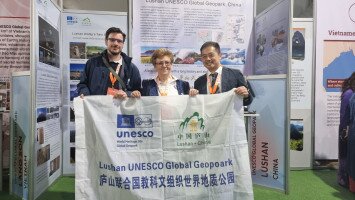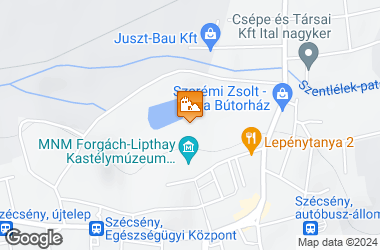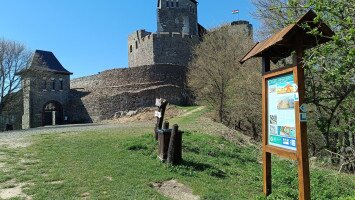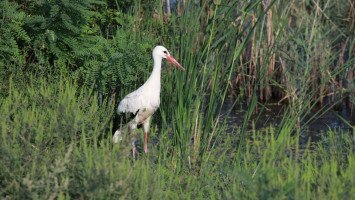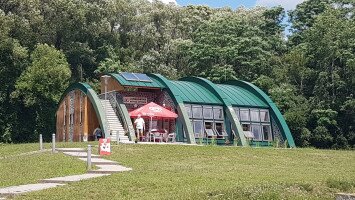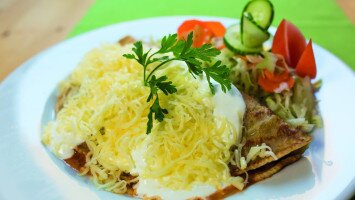| Natural area of local importance.
History
On the site of the ruins of the medieval castle, using the walls of the castle, the construction of the first castle began around 1670 by Ádám Forgách, which was rebuilt in 1750. Owned by the Count Forgách family in the 19th century. It became the property of Ferenc Pulszky from the middle of the 19th century. It was bought from his heirs in 1903 by Jenő Grosz, then in 1943 it became the property of Baron Béla Liptay.
Currently, the castle is home to the Ferenc Kubinyi Museum, which has several permanent exhibitions. The archeological exhibition “The Message of Millennia” and the “Hunting, Game Management” natural science exhibition can be seen in the castle. The "Körösi Csoma Memorial Exhibition" in the barn house and the "History of the Szécsényi Castle" exhibition can be seen in the eastern bastion.
In the first decades of the 19th century, Count József Forgách established the 15-hectare English garden in the swampy, reedy, desolate area below the castle hill with great care, diligence, effort and expense.In his monograph, Antal Mocsáry writes in detail about the design and plants of the castle park, which not only served the county's house and its audience, but also provided many people with poor day labor, even in the harshest winter, to maintain and care for the park.
Flora
The number of plant species planted and cultivated reached two thousand. Some of them were raised in greenhouses in both winter and summer, others were only put in there for the winter and there were some that were always kept in the open air. The size of the collection at that time is also indicated by the fact that e.g. there were 32 species of geranium. The following plants, which are rare at the time, were grown in the greenhouse: Devil's cotton (Abroma angusta), cornstalk dracaena (Aletris fragrans), bitter ginger (Amomum zerumbet), giant cane (Arundo donax), pineapple (Bromelia ananas), cactuses (Cactus spp.), cassia (Cassia spp.), Jessamines (Cestrum spp.), glorybower (Clerodendrum spp.), Arabian coffee (Coffea arabica), ginger (Costus speciosus), swamp lilies (Crinum spp.), fig trees (Ficus spp.) , hibiscus (Hibiscus spp.), acacia (Mimosa spp.), bananas (Musa spp.), green-tinge spiderlily (Pancratium caribaeum), passion flower (Passiflora spp.), date palm (Phoenix dactylifera), pepper (Piper spp.), sugar cane (Sacharum officinarum), vanilla (Vanilia aromatica).
The following plant rarities were included in the greenhouse in winter: African Lily (Agapanthus umbellatus), aloe (Aloe spp.), Japanese laurel (Aucuba japonica), Japanese camellia (Camelia japonica), true laurel (Laurus nobilis), Southern Magnolia ( Magnolia grandiflora), ice plants (Mesembryanthemum spp.), Woody peony (Paeonia arborea), geranium (Pelargonium spp.), Great rhododendron (Rhododendron maximum), Pontic rhododendron (Rhododendron ponticum), Japanese teats (Sophora spp. ), glorious yucca (Yucca gloriosa).
The following species, among others, were grown outdoors throughout the year: ashleaf maple (Acer negundo), striped maple (Acer pensylvanicum), red maple (Acer rubrum), silver maple (Acer sacharinum), varnish tree (Ailanthus glandulosa), trumpet tree (Bignonia catal) ), ash (Fraxinus spp.),thorny locust (Gleditsia spp.), Canadian iron (Guilandina dioica), goldenrain tree (Koelreuteria paniculata), American tulip tree (Liriodendron tulipifera), balsam fir (Pinus balsamea), red cedars (Cedrus spp.), pine (Pinus strobus), balsam poplar (Populus balsamifera), Ontario poplar (Populus candicans), roses (Rosa spp.).
Design of the park
The landscape park, built in the English style, was able to take advantage of the landscape. Lakes were built under the castle building, fish were planted in them, swans and wild ducks visited the water. The park was lined with walkways. The former castle bastion was used as a garden rest house, an artificial cave was built near it. Inside, the water that led there rushed down on stalactite-shaped rocks, and then a small vein led the water into the lake. The artificial cave was built of stones from the Somoskő basalt. In the more distant parts of the park, the so-called viaduct, rain gate and viewpoint hill appeared.
Rehabilitation of the park
In 2004, the Municipality of the City of Szécsény won almost 2 million 11 thousand euros from the Phare Regional Development Program 2002-2003 with the project "Rehabilitation of the historical city center of Szécsény". As part of this, the state-owned castle and park, which is exclusively owned by the state, were renovated. During the rehabilitation that took place between 2004 and 2006, some of the remaining old trees were preserved and several seedlings were planted. Walkways and benches have been set up, creating a valuable green space and resting place for the urban population. |
